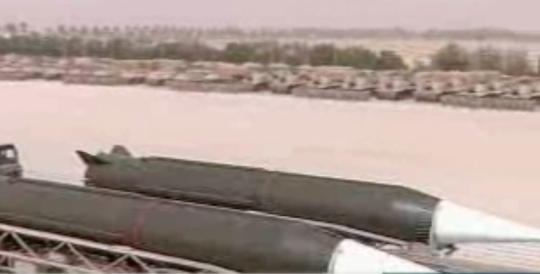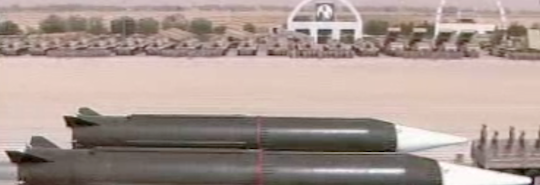Saudi Arabia’s military for the first time displayed Chinese made intermediate-range missiles during a recent military parade in the kingdom.
The unveiling of the two Chinese DF-3 missiles is the latest sign that the oil-rich kingdom is distancing itself from the United States.
The missiles were shown during a large-scale military parade featuring troops, warplanes and other military hardware. The parade marked the end of a large military exercise known as Abdullah’s Sword that ended April 29 in northeastern region of Hafar al Batan.
The DF-3s were purchased by the Saudis in a secret deal with Beijing in 1987 and the sale was the first time intermediate-range missiles had been exported.
The missiles are considered nuclear-capable because their accuracy as conventionally armed weapons is limited.

Security analysts have speculated that the DF-3s are part of a secret agreement between the kingdom and Pakistan to share some of Islamabad’s nuclear warheads for the missiles in a future crisis or conflict.
Saudi Arabia is an arch foe of Iran and has been pressing the Obama administration to take a more forceful posture toward ending Iran’s covert nuclear arms program.
The disclosure of the missiles follows a recent visit to China by Saudi defense officials who U.S. officials say are angered at the Obama administration over its policies toward Iran.
Saudi Crown Prince and Defense Minister Salman bin Abdulaziz al-Saud traveled to Pakistan in February. U.S. officials said the visit was an indication that the Saudis are preparing to purchase Chinese-designed JF-17 combat jets from the Pakistanis.
Saudi Deputy Defense Minister Prince Salman bin Sultan also visited Pakistan’s Heavy Industries Taxila fueling reports that the Saudi are buying the Chinese-Pakistani Al-Khalid tank.
The visit was viewed by U.S. officials as a clear indicator of Saudi anger at conciliatory Obama administration policies toward a deal with Iran on its nuclear program, and a perception in Riyadh that the United States is not supporting its friends.
Simon Henderson, a Middle East analyst with the Washington Institute, said the display of the missiles appears to be Saudi "messaging" to both the United States and Iran.
"These missiles were supplied to Saudi Arabia in 1987 and have long been based in the mountainous desert well south of Riyadh, from where they can target Iran," Henderson said in a written analysis.
"The missile display signals Saudi Arabia's determination to counter Tehran's growing strength, as well as its readiness to act independently of the United States," he said. "In particular, the presence of Pakistan's top military commander [at the Saudi military parade] will reawaken speculation that Riyadh may seek to acquire nuclear warheads from Islamabad to match Iran's potential."
On relations with the United States, Henderson said reports from the summit in March between President Obama and King Abdullah revealed it was a "difficult" meeting.
Saudi Arabia in the past assured the United States that the DF-3 would not be equipped with nuclear warheads.

Newsweek reported Jan. 29 that China also secretly supplied Saudi Arabia with more advanced DF-21 medium range missiles—among Beijing’s most advanced missiles that have been modified for use in attacking satellites and aircraft carriers at sea.
No DF-21s were displayed during the military parade.
"For Washington, the Saudi display is a reminder that Riyadh remains profoundly concerned about the course of events in the region," Henderson said. "As the dominance of U.S.-supplied equipment in the parade indicated, Washington is still the kingdom's preferred security partner, but the relationship continues to show signs of being frayed."
Saudi press reports said the military exercises last month were the largest in the country’s history and involved tens of thousands of troops, jets, helicopters, ships and anti-missile systems.
"We are preparing our armed forces to protect the nation. The armed forces do not aim to attack anyone as this is not our wise government’s policy," Lt. Gen. Hussian al Qabeel told state media.
According to U.S. officials, another sign that Saudi Arabia appears to be limiting its long-time friendship with the United States was the ouster last month of its intelligence chief, Prince Bandar bin Sultan, a former ambassador to the United States who was considered one of the most pro-U.S. officials in Riyadh.
News reports from the Middle East stated that Bandar was directing Saudi efforts to finance, arm and support Syrian rebels seeking the overthrow of the Bashar Assad regime in Damascus.
Bandar had been intelligence chief since 2012 and his departure from the post is widely regarded as an indication of a major shift in Saudi policy away from the United States.